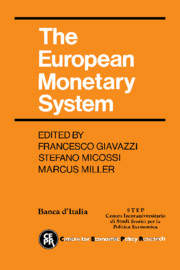Book contents
- Frontmatter
- Contents
- List of figures
- List of tables
- Preface
- Conference participants
- 1 Introduction
- I THE INTERNATIONAL ENVIRONMENT
- 2 The European Monetary System, the dollar and the yen
- II DISINFLATION, EXTERNAL ADJUSTMENT AND COOPERATION
- 4 The role of the exchange-rate regime in a disinflation: empirical evidence on the European Monetary System
- 5 Inflation and the European Monetary System
- 6 Economic growth and exchange rates in the European Monetary System: their trade effects in a changing external environment
- III EXCHANGE RATES, CAPITAL MOBILITY AND MONETARY COORDINATION
- IV THE FUTURE OF THE EUROPEAN MONETARY SYSTEM
- Index
2 - The European Monetary System, the dollar and the yen
Published online by Cambridge University Press: 12 March 2010
- Frontmatter
- Contents
- List of figures
- List of tables
- Preface
- Conference participants
- 1 Introduction
- I THE INTERNATIONAL ENVIRONMENT
- 2 The European Monetary System, the dollar and the yen
- II DISINFLATION, EXTERNAL ADJUSTMENT AND COOPERATION
- 4 The role of the exchange-rate regime in a disinflation: empirical evidence on the European Monetary System
- 5 Inflation and the European Monetary System
- 6 Economic growth and exchange rates in the European Monetary System: their trade effects in a changing external environment
- III EXCHANGE RATES, CAPITAL MOBILITY AND MONETARY COORDINATION
- IV THE FUTURE OF THE EUROPEAN MONETARY SYSTEM
- Index
Summary
This study discusses challenges to international monetary stability in the coming years. Are the current levels of exchange rates (with allowance for moderate trends due to divergent inflation) substantially sustainable and is the European Monetary System (EMS) sustainable with its current institutional structure? I will argue that a number of problems remain unresolved and are likely to bring about major exchange-rate problems in the coming years:
(a) The EMS is inefficient as an adjustable-peg, low-inflation system. It would be improved by an explicit shift to a crawling-peg or constant real exchange-rate model.
(b) The US is insufficiently competitive at the current exchange rate and therefore will opt for depreciation or protection.
(c) The world real interest rate needs to decline sharply, a situation more strongly accepted and recognised in the US than elsewhere.
But there is also a wave of renewed interest in reforming the international monetary system by a return to more nearly fixed exchange rates.
Such an idea has been advocated by McKinnon over the past few years and is strongly argued in a recent ‘blueprint’ by Williamson and Miller (1987). These proposals subordinate macroeconomic policies and policy coordination to the vagaries of capital flows. A preferable alternative, as I shall argue, is to segment the capital account by a dual exchange-rate system.
(d) If capital controls are unacceptable and policy coordination is considered undesirable it is worthwhile giving serious attention to dual exchange rates among industrialised countries. This would reinforce the partial dual exchange-rate system that Europe and the US in fact have.
- Type
- Chapter
- Information
- The European Monetary System , pp. 23 - 48Publisher: Cambridge University PressPrint publication year: 1988
- 18
- Cited by

